height Hyundai Elantra 2018 Owner's Manual
[x] Cancel search | Manufacturer: HYUNDAI, Model Year: 2018, Model line: Elantra, Model: Hyundai Elantra 2018Pages: 526, PDF Size: 17.2 MB
Page 20 of 526
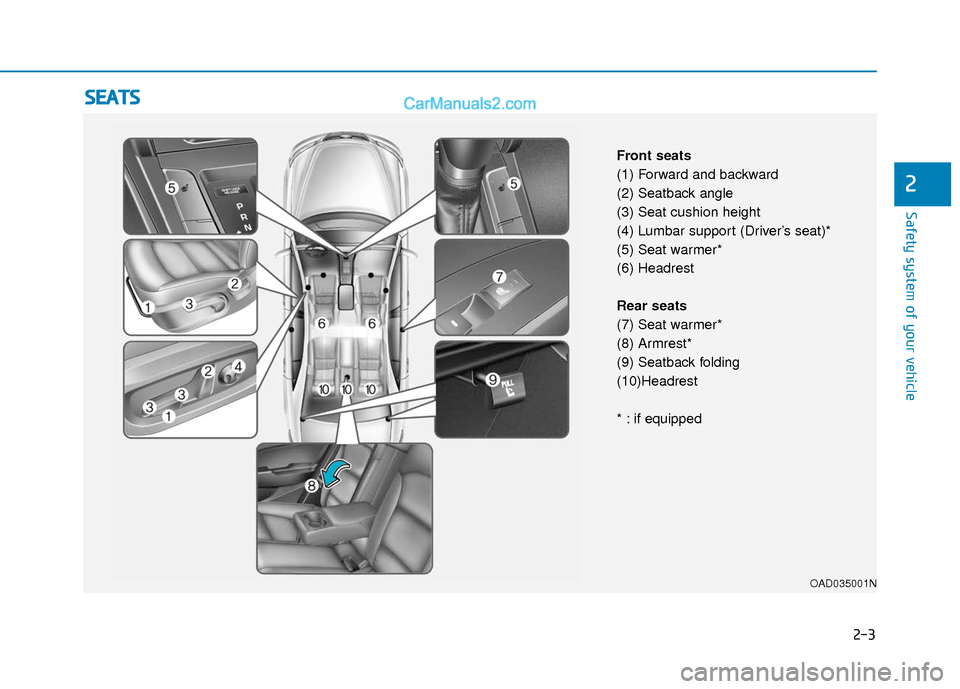
2-3
Safety system of your vehicle
2
S
SE
E A
A T
TS
S
OAD035001N
Front seats
(1) Forward and backward
(2) Seatback angle
(3) Seat cushion height
(4) Lumbar support (Driver’s seat)*
(5) Seat warmer*
(6) Headrest
Rear seats
(7) Seat warmer*
(8) Armrest*
(9) Seatback folding
(10)Headrest
* : if equipped
Page 23 of 526
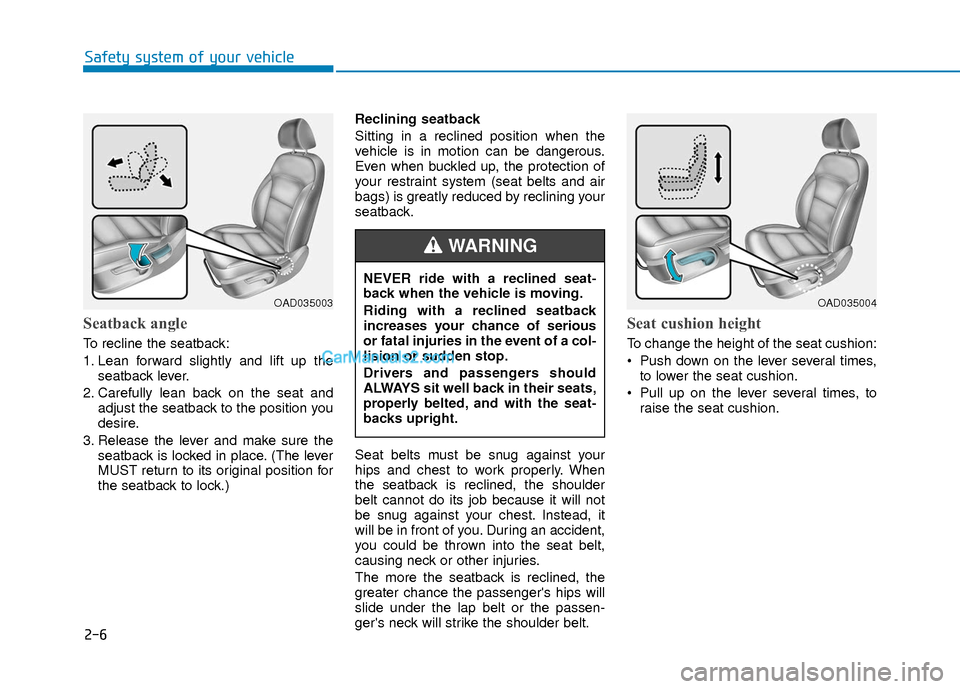
2-6
Safety system of your vehicle
Seatback angle
To recline the seatback:
1. Lean forward slightly and lift up theseatback lever.
2. Carefully lean back on the seat and adjust the seatback to the position you
desire.
3. Release the lever and make sure the seatback is locked in place. (The lever
MUST return to its original position for
the seatback to lock.) Reclining seatback
Sitting in a reclined position when the
vehicle is in motion can be dangerous.
Even when buckled up, the protection of
your restraint system (seat belts and air
bags) is greatly reduced by reclining your
seatback.
Seat belts must be snug against your
hips and chest to work properly. When
the seatback is reclined, the shoulder
belt cannot do its job because it will not
be snug against your chest. Instead, it
will be in front of you. During an accident,
you could be thrown into the seat belt,
causing neck or other injuries.
The more the seatback is reclined, the
greater chance the passenger's hips will
slide under the lap belt or the passen-
ger's neck will strike the shoulder belt.
Seat cushion height
To change the height of the seat cushion:
Push down on the lever several times,
to lower the seat cushion.
Pull up on the lever several times, to raise the seat cushion.
OAD035003OAD035004
NEVER ride with a reclined seat-
back when the vehicle is moving.
Riding with a reclined seatback
increases your chance of serious
or fatal injuries in the event of a col-
lision or sudden stop.
Drivers and passengers should
ALWAYS sit well back in their seats,
properly belted, and with the seat-
backs upright.
WARNING
Page 25 of 526
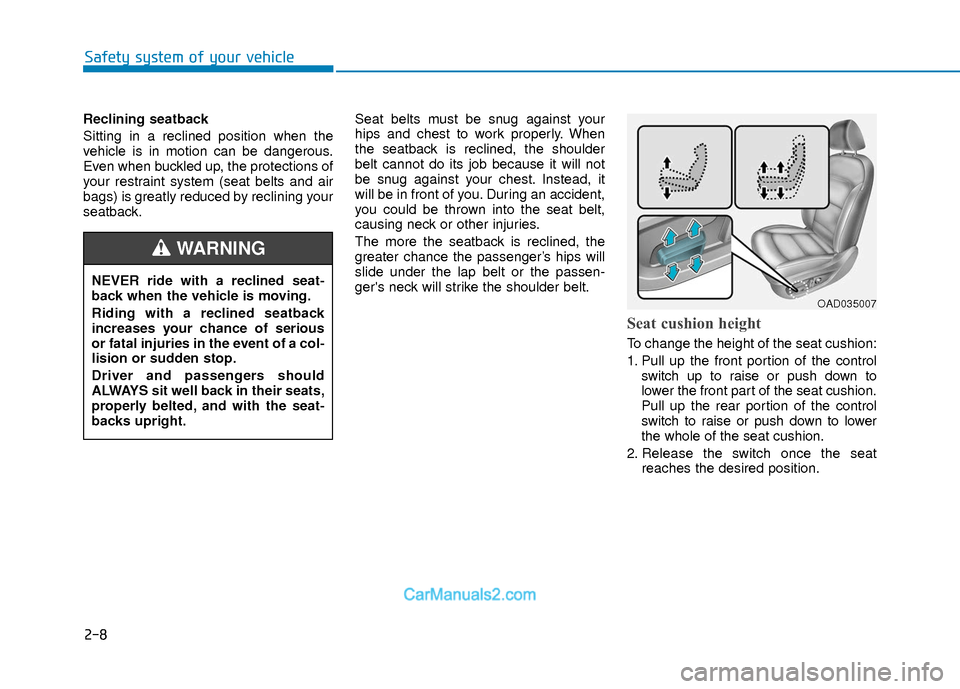
2-8
Safety system of your vehicle
Reclining seatback
Sitting in a reclined position when the
vehicle is in motion can be dangerous.
Even when buckled up, the protections of
your restraint system (seat belts and air
bags) is greatly reduced by reclining your
seatback.Seat belts must be snug against your
hips and chest to work properly. When
the seatback is reclined, the shoulder
belt cannot do its job because it will not
be snug against your chest. Instead, it
will be in front of you. During an accident,
you could be thrown into the seat belt,
causing neck or other injuries.
The more the seatback is reclined, the
greater chance the passenger’s hips will
slide under the lap belt or the passen-
ger's neck will strike the shoulder belt.
Seat cushion height
To change the height of the seat cushion:
1. Pull up the front portion of the control
switch up to raise or push down to
lower the front part of the seat cushion.
Pull up the rear portion of the control
switch to raise or push down to lower
the whole of the seat cushion.
2. Release the switch once the seat reaches the desired position.
NEVER ride with a reclined seat-
back when the vehicle is moving.
Riding with a reclined seatback
increases your chance of serious
or fatal injuries in the event of a col-
lision or sudden stop.
Driver and passengers should
ALWAYS sit well back in their seats,
properly belted, and with the seat-
backs upright.
WARNING
OAD035007
Page 30 of 526
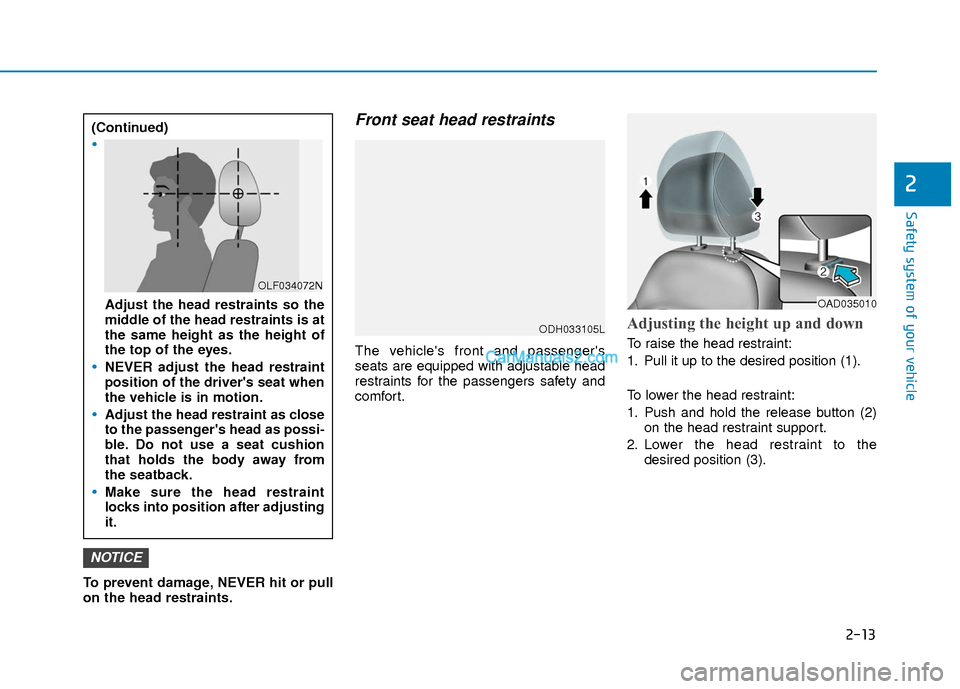
2-13
Safety system of your vehicle
2
To prevent damage, NEVER hit or pull
on the head restraints.
Front seat head restraints
The vehicle's front and passenger's
seats are equipped with adjustable head
restraints for the passengers safety and
comfort.
Adjusting the height up and down
To raise the head restraint:
1. Pull it up to the desired position (1).
To lower the head restraint:
1. Push and hold the release button (2)on the head restraint support.
2. Lower the head restraint to the desired position (3).
NOTICE
(Continued)
Adjust the head restraints so the
middle of the head restraints is at
the same height as the height of
the top of the eyes.
NEVER adjust the head restraint
position of the driver's seat when
the vehicle is in motion.
Adjust the head restraint as close
to the passenger's head as possi-
ble. Do not use a seat cushion
that holds the body away from
the seatback.
Make sure the head restraint
locks into position after adjusting
it.
OLF034072N
ODH033105L
OAD035010
Page 31 of 526
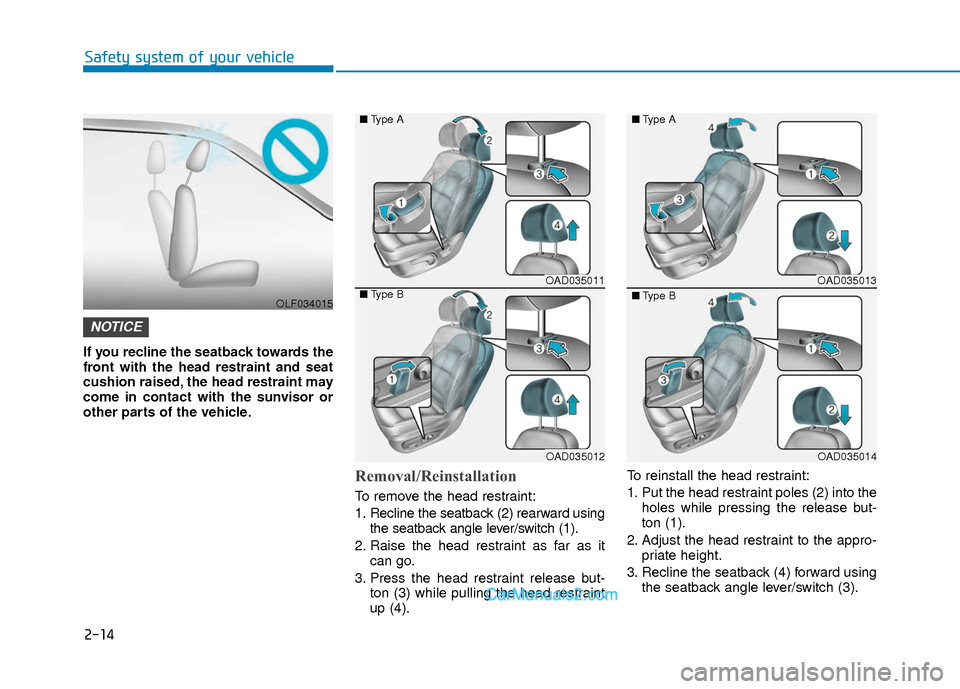
2-14
Safety system of your vehicle
If you recline the seatback towards the
front with the head restraint and seat
cushion raised, the head restraint may
come in contact with the sunvisor or
other parts of the vehicle.
Removal/Reinstallation
To remove the head restraint:
1. Recline the seatback (2) rearward usingthe seatback angle lever/switch (1).
2. Raise the head restraint as far as it can go.
3. Press the head restraint release but- ton (3) while pulling the head restraint
up (4). To reinstall the head restraint:
1. Put the head restraint poles (2) into the
holes while pressing the release but-
ton (1).
2. Adjust the head restraint to the appro- priate height.
3. Recline the seatback (4) forward using the seatback angle lever/switch (3).
NOTICE
OLF034015
OAD035011
OAD035012
■Type A
■Type BOAD035013
OAD035014
■Type A
■Type B
Page 32 of 526
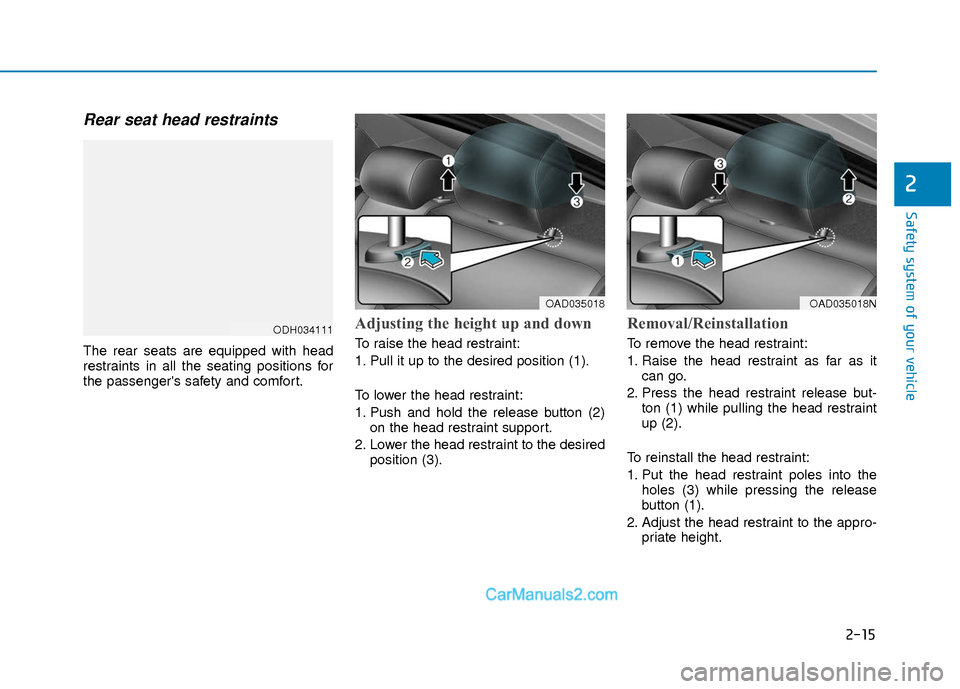
2-15
Safety system of your vehicle
2
Rear seat head restraints
The rear seats are equipped with head
restraints in all the seating positions for
the passenger's safety and comfort.
Adjusting the height up and down
To raise the head restraint:
1. Pull it up to the desired position (1).
To lower the head restraint:
1. Push and hold the release button (2)on the head restraint support.
2. Lower the head restraint to the desired position (3).
Removal/Reinstallation
To remove the head restraint:
1. Raise the head restraint as far as itcan go.
2. Press the head restraint release but- ton (1) while pulling the head restraint
up (2).
To reinstall the head restraint:
1. Put the head restraint poles into the holes (3) while pressing the release
button (1).
2. Adjust the head restraint to the appro- priate height.ODH034111
OAD035018OAD035018N
Page 38 of 526
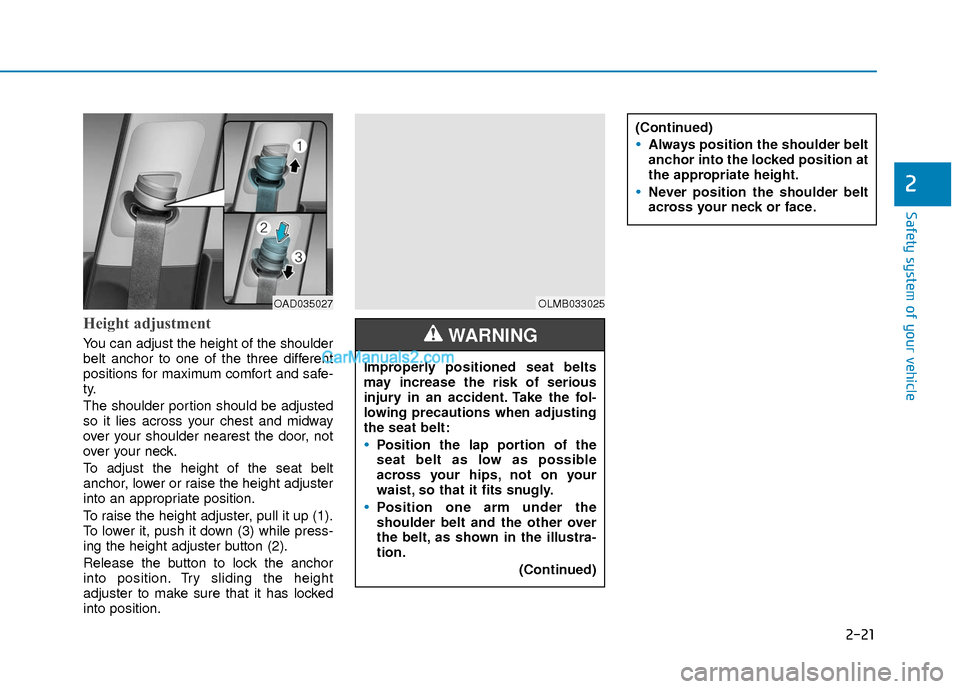
2-21
Safety system of your vehicle
2
Height adjustment
You can adjust the height of the shoulder
belt anchor to one of the three different
positions for maximum comfort and safe-
ty.
The shoulder portion should be adjusted
so it lies across your chest and midway
over your shoulder nearest the door, not
over your neck.
To adjust the height of the seat belt
anchor, lower or raise the height adjuster
into an appropriate position.
To raise the height adjuster, pull it up (1).
To lower it, push it down (3) while press-
ing the height adjuster button (2).
Release the button to lock the anchor
into position. Try sliding the height
adjuster to make sure that it has locked
into position.
OAD035027
(Continued)
Always position the shoulder belt
anchor into the locked position at
the appropriate height.
Never position the shoulder belt
across your neck or face.
OLMB033025
Improperly positioned seat belts
may increase the risk of serious
injury in an accident. Take the fol-
lowing precautions when adjusting
the seat belt:
Position the lap portion of the
seat belt as low as possible
across your hips, not on your
waist, so that it fits snugly.
Position one arm under the
shoulder belt and the other over
the belt, as shown in the illustra-
tion.(Continued)
WARNING
Page 43 of 526
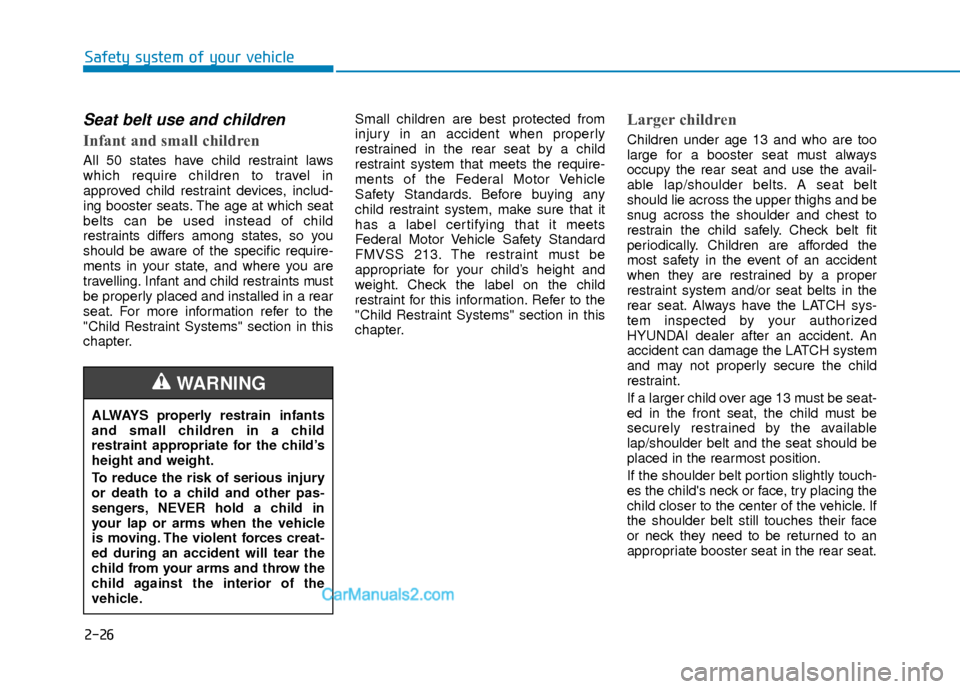
2-26
Safety system of your vehicle
Seat belt use and children
Infant and small children
All 50 states have child restraint laws
which require children to travel in
approved child restraint devices, includ-
ing booster seats. The age at which seat
belts can be used instead of child
restraints differs among states, so you
should be aware of the specific require-
ments in your state, and where you are
travelling. Infant and child restraints must
be properly placed and installed in a rear
seat. For more information refer to the
"Child Restraint Systems" section in this
chapter.Small children are best protected from
injury in an accident when properly
restrained in the rear seat by a child
restraint system that meets the require-
ments of the Federal Motor Vehicle
Safety Standards. Before buying any
child restraint system, make sure that it
has a label certifying that it meets
Federal Motor Vehicle Safety Standard
FMVSS 213. The restraint must be
appropriate for your child’s height and
weight. Check the label on the child
restraint for this information. Refer to the
"Child Restraint Systems" section in this
chapter.
Larger children
Children under age 13 and who are too
large for a booster seat must always
occupy the rear seat and use the avail-
able lap/shoulder belts. A seat belt
should lie across the upper thighs and be
snug across the shoulder and chest to
restrain the child safely. Check belt fit
periodically. Children are afforded the
most safety in the event of an accident
when they are restrained by a proper
restraint system and/or seat belts in the
rear seat. Always have the LATCH sys-
tem inspected by your authorized
HYUNDAI dealer after an accident. An
accident can damage the LATCH system
and may not properly secure the child
restraint.
If a larger child over age 13 must be seat-
ed in the front seat, the child must be
securely restrained by the available
lap/shoulder belt and the seat should be
placed in the rearmost position.
If the shoulder belt portion slightly touch-
es the child's neck or face, try placing the
child closer to the center of the vehicle. If
the shoulder belt still touches their face
or neck they need to be returned to an
appropriate booster seat in the rear seat.
ALWAYS properly restrain infants
and small children in a child
restraint appropriate for the child’s
height and weight.
To reduce the risk of serious injury
or death to a child and other pas-
sengers, NEVER hold a child in
your lap or arms when the vehicle
is moving. The violent forces creat-
ed during an accident will tear the
child from your arms and throw the
child against the interior of the
vehicle.
WARNING
Page 45 of 526
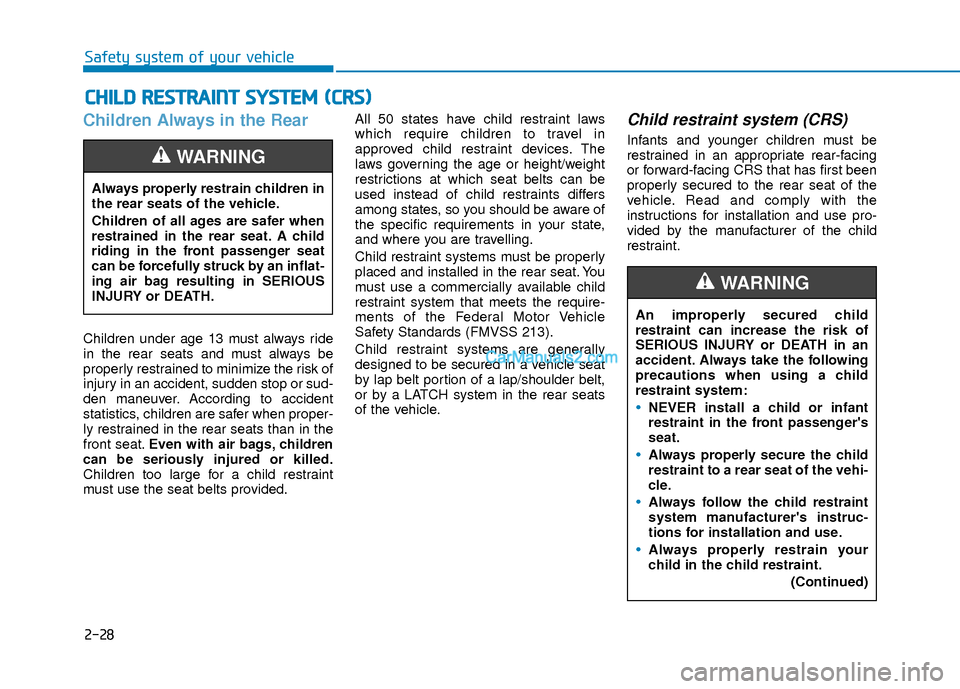
2-28
Safety system of your vehicle
Children Always in the Rear
Children under age 13 must always ride
in the rear seats and must always be
properly restrained to minimize the risk of
injury in an accident, sudden stop or sud-
den maneuver. According to accident
statistics, children are safer when proper-
ly restrained in the rear seats than in the
front seat.Even with air bags, children
can be seriously injured or killed.
Children too large for a child restraint
must use the seat belts provided. All 50 states have child restraint laws
which require children to travel in
approved child restraint devices. The
laws governing the age or height/weight
restrictions at which seat belts can be
used instead of child restraints differs
among states, so you should be aware of
the specific requirements in your state,
and where you are travelling.
Child restraint systems must be properly
placed and installed in the rear seat. You
must use a commercially available child
restraint system that meets the require-
ments of the Federal Motor Vehicle
Safety Standards (FMVSS 213).
Child restraint systems are generally
designed to be secured in a vehicle seat
by lap belt portion of a lap/shoulder belt,
or by a LATCH system in the rear seats
of the vehicle.
Child restraint system (CRS)
Infants and younger children must be
restrained in an appropriate rear-facing
or forward-facing CRS that has first been
properly secured to the rear seat of the
vehicle. Read and comply with the
instructions for installation and use pro-
vided by the manufacturer of the child
restraint.
C C
H
H I
IL
L D
D
R
R E
ES
ST
T R
R A
A I
IN
N T
T
S
S Y
Y S
ST
T E
EM
M
(
( C
C R
R S
S)
)
Always properly restrain children in
the rear seats of the vehicle.
Children of all ages are safer when
restrained in the rear seat. A child
riding in the front passenger seat
can be forcefully struck by an inflat-
ing air bag resulting in SERIOUS
INJURY or DEATH.
WARNING
An improperly secured child
restraint can increase the risk of
SERIOUS INJURY or DEATH in an
accident. Always take the following
precautions when using a child
restraint system:
NEVER install a child or infant
restraint in the front passenger's
seat.
Always properly secure the child
restraint to a rear seat of the vehi-
cle.
Always follow the child restraint
system manufacturer's instruc-
tions for installation and use.
Always properly restrain your
child in the child restraint.
(Continued)
WARNING
Page 46 of 526
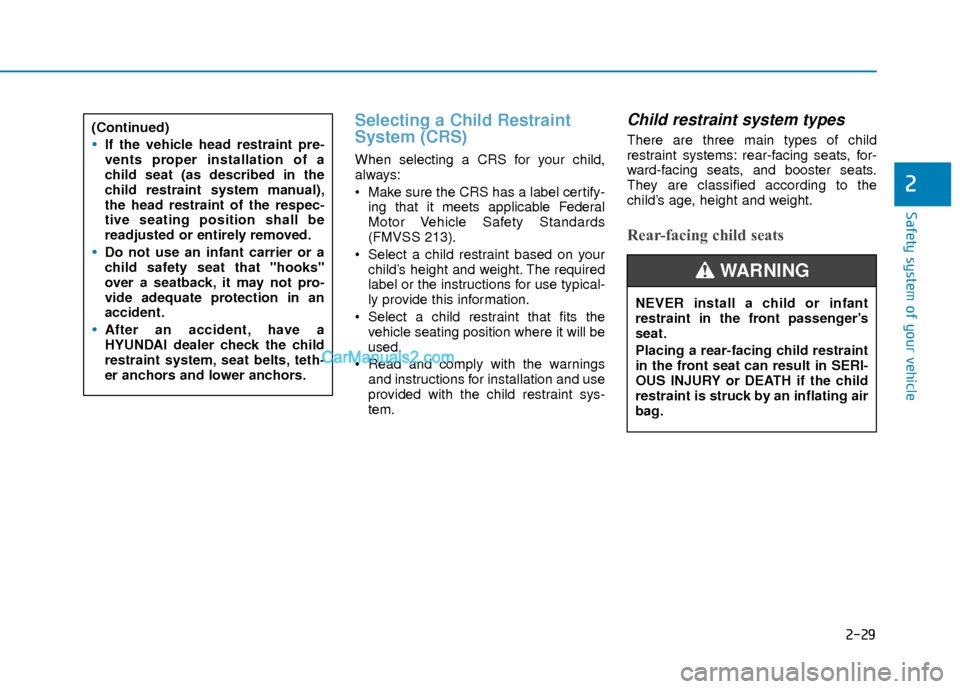
2-29
Safety system of your vehicle
2
Selecting a Child Restraint
System (CRS)
When selecting a CRS for your child,
always:
Make sure the CRS has a label certify-ing that it meets applicable Federal
Motor Vehicle Safety Standards
(FMVSS 213).
Select a child restraint based on your child’s height and weight. The required
label or the instructions for use typical-
ly provide this information.
Select a child restraint that fits the vehicle seating position where it will be
used.
Read and comply with the warnings and instructions for installation and use
provided with the child restraint sys-
tem.
Child restraint system types
There are three main types of child
restraint systems: rear-facing seats, for-
ward-facing seats, and booster seats.
They are classified according to the
child’s age, height and weight.
Rear-facing child seats
(Continued)
If the vehicle head restraint pre-
vents proper installation of a
child seat (as described in the
child restraint system manual),
the head restraint of the respec-
tive seating position shall be
readjusted or entirely removed.
Do not use an infant carrier or a
child safety seat that "hooks"
over a seatback, it may not pro-
vide adequate protection in an
accident.
After an accident, have a
HYUNDAI dealer check the child
restraint system, seat belts, teth-
er anchors and lower anchors.
NEVER install a child or infant
restraint in the front passenger’s
seat.
Placing a rear-facing child restraint
in the front seat can result in SERI-
OUS INJURY or DEATH if the child
restraint is struck by an inflating air
bag.
WARNING